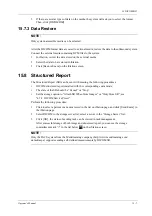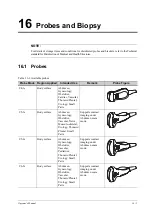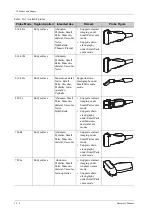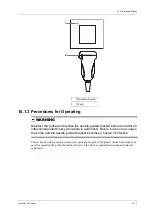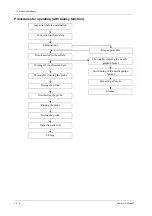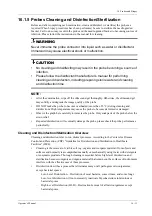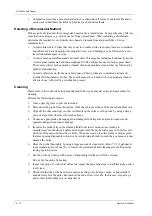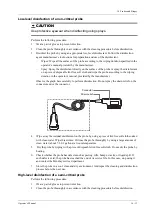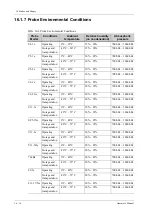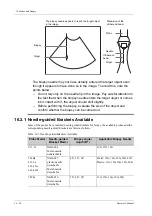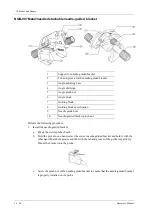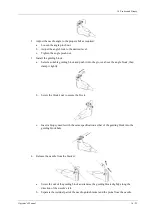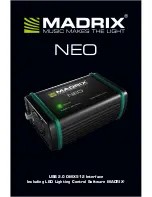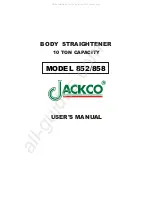
16 - 12
Operator’s Manual
16 Probes and Biopsy
•
Sterilization describes a process that destroys or eliminates all forms of microbial life and is
carried out in healthcare facilities by physical or chemical methods.
Selecting a Microbicidal Method
Probes can be divided into three categories based on their intended use. Some probes may fall into
more than one category (e.g. probes use for biopsy procedures). When selecting a disinfectant,
determine the required level of disinfection based on intended use and possibility of cross-
contamination.
•
Contacts intact skin: Probes that only come into contact with clean, intact skin are considered
noncritical devices and require cleaning after every use. Cleaning may be followed by a low-
level disinfectant spray or wipe.
•
Contacts mucous membranesand non-intact skin: This category includes all endocavity probes
- intravaginal, transrectal, and transesophageal (TEE) and probes use for biopsy procedures.
These semi-critical probes must be cleaned with an appropriate cleaner after use followed by
high-level disinfection.
•
Contacts otherwise sterile tissue or body-space: These probes are considered critical and
include all intraoperative probes. These probes must be cleaned with an appropriate cleaner
after each use, followed by a sterilization process.
Cleaning
Please refer to the instructions in the manual and follow your hospital policy and procedures for
cleaning.
Perform the following procedure:
1.
Wear a pair of gloves to prevent infection.
2.
Disconnect the probe from the system. If the sheath is used, take off the sheath and discard it.
3.
Wipe off the ultrasound gel or other visible dirt on the surface of the probe by using a damp
piece of disposable lint-free soft cloth or tissue.
4.
Choose an appropriate cleaning agent including mild detergents, enzymatic cleaners and
specially designed enzymatic sponges.
5.
Immerse the probe fully in the cleaning fluid for at least 1 minute or according to
manufacturer’s instructions. Lightly mechanical clean the probe with a piece of lint-free soft
cloth or soft sponge until no dirt is visible. When necessary, clean the seams or biopsy guide
features by using disposable cotton swabs. Avoid using a brush to wash the lens because it may
damage the probe.
6.
Rinse the probe thoroughly by using a large amount of clean water (about 7.5 L/2 gallons) at
room temperature for about 30 s to remove the residual dirt and cleaning solvent. Repeat the
rinsing operation twice.
7.
Dry the probe by wiping with a piece of disposable lint-free soft cloth or tissue.
Do not dry the probe by heating.
8.
Inspect the probe. If visible dirt still exists, repeat the preceding steps to wash the probe until it
is all clean.
9.
Check whether the probe has defects such as peeling, rifts, bumps, cracks, or liquid spill. If
such defects exist, the probe has reached the end of its service life. In this case, stop using it
and contact the Mindray service department.
Summary of Contents for Ana
Page 2: ......
Page 50: ...This page intentionally left blank...
Page 60: ...This page intentionally left blank...
Page 110: ...This page intentionally left blank...
Page 116: ...This page intentionally left blank...
Page 166: ...This page intentionally left blank...
Page 176: ...This page intentionally left blank...
Page 194: ...This page intentionally left blank...
Page 220: ...This page intentionally left blank...
Page 288: ...This page intentionally left blank...
Page 304: ...This page intentionally left blank...
Page 308: ...This page intentionally left blank...
Page 316: ...This page intentionally left blank...
Page 337: ......
Page 338: ...P N 046 018835 00 2 0...


